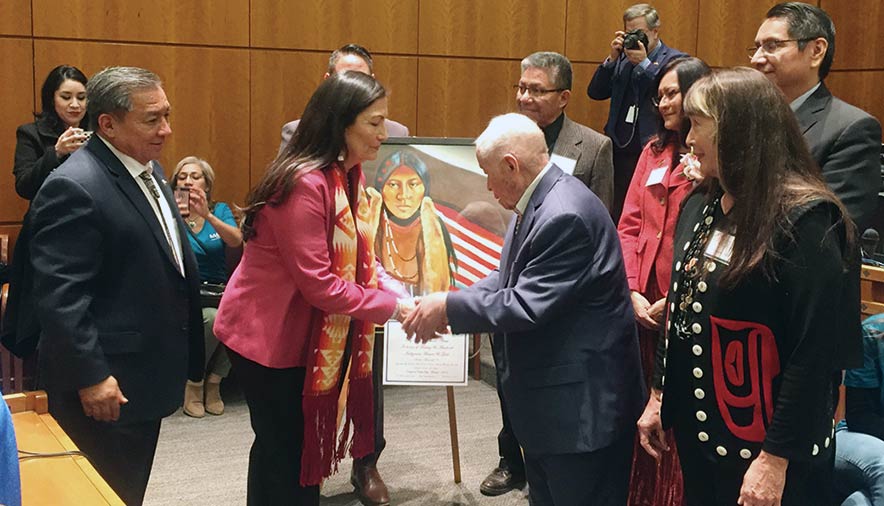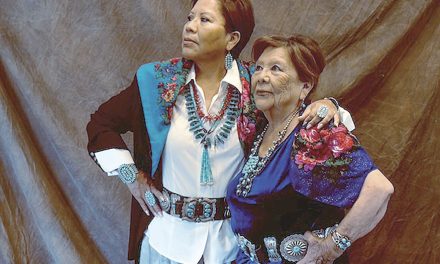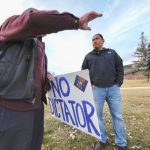
Governor makes missing, murdered priority; all asked to help

Courtesy photo | Charmaine Jackson
During the state’s American Indian Day in 2019, State Sen. John Pinto recognizes then-Rep. Deb Haaland’s attention to the epidemic of murdered and missing indigenous women and relatives.
By Colleen Keane
Special to the Times
ALBUQUERQUE
New Mexico Gov. Michelle Lujan Grisham has signed an executive order to expand the state’s Missing and Murdered Indigenous Women and Girls Task Force.
“I was really pleased that the governor continues to prioritize this work for our tribal communities especially on May 5th, the national day of recognition for the missing and murdered,” said Stephanie Salazar, chief counsel for state Indian Affairs Department.
The initial task force created by HB 278 in 2019 was charged with making recommendations to the governor on how to end the violence once and for all.
She received their findings, prepared in partnership with the Native American Budget Policy Institute, last December.
The report, which can be found on the IAD website along with the executive order, gave Lujan Grisham the information she needed.
“Governor Lujan Grisham stepped up with the executive order. It was really important that happened,” said Patricia Michaels, Taos Pueblo, an internationally recognized fashion designer who advocates for the murdered and missing. “This (epidemic) is killing our people and it needs to be stopped. I’m grateful she made it a priority.”
‘This is genocide’
As referenced by the MMIWG task force report:
- In 2016, more than 5,700 indigenous women and girls were reported missed or murdered to the National Crime Information Center.
- The following year, the Urban Indian Health Institute began looking closely at 506 specific cases in 71 cities. Albuquerque and Gallup were on the top of the list for the highest number of murders and disappearances. Albuquerque had 37, Gallup 25 with a total of 78 cases across the state.
- In 2018, the Centers for Disease and Control and Prevention announced that murder is one of the leading causes of death among American Indian and Alaska Natives. In some areas, women and girls are murdered at a rate 10 times the national average, (a figure that surfaced years before and hasn’t changed.)
“There is no sugar coating. This is genocide!” said Michaels.
She added, “I wake up every morning praying for the missing and murdered. It hits me during the day that somebody is being abducted, hurt, traumatized, fighting for their lives. It is so real, you can’t turn a blind eye,” she stressed.
In her executive order, Lujan Grisham recognizes that violence against Indigenous people is entrenched in New Mexico’s history.
She points out that stopping the violence calls for multiple responses — “adequate tribal law enforcement, coordinated communication between Native and non-Native public safety departments to deal with the “complex maze of jurisdictions.”
The effort also needs a united data collection effort, increased support services for survivors, families and tribal justice systems, technology-driven reporting, education and training and federal legislation that respects tribal sovereignty — the Tribal Law and Order Act and Violence Against Women Act.
The governor’s executive order also expands the scope of the task force.
“This is not just a crisis with our women and girls. There are more men that are missing or murdered than there are women,” stated a community member quoted in the task force report.
Boys and members of the LGBTQ2S+ community are also at risk, Michaels pointed out in an interview with the Times in 2019.
Acknowledging how widespread murders and disappearances are in urban areas and on tribal lands, the task force renamed itself the Missing and Murdered Indigenous Women and Relatives Task Force.
Also, under the governor’s order, the original task force increased from 11 members to 40 including state workers, legislators, tribal and urban community reps and staff from justice programs.
“The governor’s order takes the task force to the next step,” Salazar said. “We would like to see strategies (and actions) for long-term continuity of this work.:
All welcome
Salazar said that even if individuals or organizations are not named in the executive order as task force members, everyone is welcome to help stop the violence, Native and non-Native.
“What we have learned is that the more people we have in the (virtual or face-to-face) room, we’re going to come up with good strategies,” she said.
As a community advocate, Michaels has incorporated raising awareness into her fashion business for years.
In 2019, answering a call from the late State Sen. John Pinto, Michaels designed a themed dress to honor victims and survivors. “Absconding with The Wild Berries” was presented to a packed audience in the rotunda on American Indian Day, Feb. 14.
“These missing and murdered indigenous women and girls are someone’s daughter, wife, auntie and mother and not just a number,” said Pinto, who sponsored SM38 supporting then-Congresswoman Deb Haaland’s national investigation.
“This is a terrible tragedy and our state’s investigations must begin now,” he said.
Recently, Michaels unveiled a dynamic fashion exhibit of several garments addressing murders and disappearances at the Dairy Arts Center in Boulder, Colorado.
She encourages other business owners to step up and raise awareness.
“Everybody can do something!” she said.
Giving examples, she suggested messages based on IAD’s findings can be sent out in social media, blended into TV and film scripts, while more survivors speak out and tell their stories.
“I want women to share their stories, which they can do anonymously, so the record shows the patterns and makes a difference,” she suggested.
Michaels said while she’s holding exhibits around the country, she’ll share New Mexico’s model to stop the violence.
“I’m spreading the word,” she said.
Salazar added, “New Mexico is a model for other states. Our work has been elevated from the amount of support (the task force) received from our leadership,” referring to support from the governor, the New Mexico legislature and Lynn Trujillo, IAD’s cabinet secretary.
Moving forward, there will be a virtual MMIWR public meeting at the end of June.
Information: 505-476-1600.








 Highway 264,
Highway 264, I-40, WB @ Winslow
I-40, WB @ Winslow